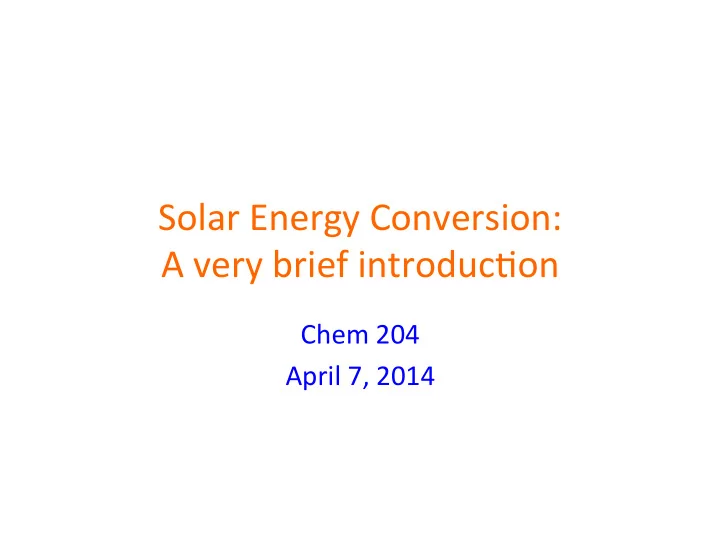

Solar ¡Energy ¡Conversion: ¡ A ¡very ¡brief ¡introduc8on ¡ Chem ¡204 ¡ April ¡7, ¡2014 ¡
Worldwide ¡energy ¡usage ¡
Worldwide ¡energy ¡usage ¡ Now: ¡about ¡15 ¡TW ¡ (15 ¡x ¡10 12 ¡J/s) ¡
From ¡Chemistry: ¡the ¡Central ¡Science, ¡12 th ¡ed. ¡
Quick ¡calcula8on ¡ • 168 ¡W/m 2 ¡of ¡sunlight ¡strikes ¡Earth’s ¡surface ¡ • Surface ¡area ¡of ¡Earth’s ¡land: ¡149 ¡x ¡10 6 ¡km 2 ¡ • Therefore, ¡2.50 ¡x ¡10 16 ¡W ¡sunlight ¡hits ¡Earth’s ¡ landmass ¡
Quick ¡calcula8on ¡ • 168 ¡W/m 2 ¡of ¡sunlight ¡strikes ¡Earth’s ¡surface ¡ • Surface ¡area ¡of ¡Earth’s ¡land: ¡149 ¡x ¡10 6 ¡km 2 ¡ • Therefore, ¡2.50 ¡x ¡10 16 ¡W ¡sunlight ¡hits ¡Earth’s ¡ landmass ¡ • The ¡energy ¡from ¡the ¡Sun ¡that ¡hits ¡Earth’s ¡ landmass ¡in ¡one ¡hour ¡(9.0 ¡x ¡10 19 ¡J) ¡is ¡sufficient ¡ to ¡power ¡the ¡planet ¡for ¡about ¡3 ¡months ¡at ¡ present ¡rate ¡of ¡consump8on ¡
Photovoltaics, ¡solar ¡hea8ng, ¡solar ¡ fuels ¡ Photovoltaic: ¡direct ¡sunlight ¡to ¡electricity ¡ ¡ ¡ ¡ ¡ ¡ ¡ ¡ ¡ ¡ ¡ ¡ ¡Solar ¡thermal ¡power ¡plant: ¡sunlight ¡drives ¡steam ¡turbine ¡ Solar ¡fuels: ¡sunlight ¡into ¡chemicals ¡ (“ar8ficial ¡photosynthesis”; ¡“ar8ficial ¡leaf”) ¡
Wavelengths ¡of ¡sunlight ¡that ¡reach ¡ Earth’s ¡surface ¡
Wavelengths ¡of ¡sunlight ¡that ¡reach ¡ Earth’s ¡surface ¡ Want ¡material ¡that ¡absorbs ¡ a ¡lot ¡of ¡solar ¡photons! ¡
Wavelengths ¡of ¡sunlight ¡that ¡reach ¡ Earth’s ¡surface ¡ Silicon! ¡Earth-‑abundant, ¡bandgap ¡ 1.1 ¡eV ¡(about ¡1100 ¡nm) ¡
Silicon ¡photovoltaics: ¡pn ¡junc8on ¡ Upon ¡contact: ¡ Fermi ¡levels ¡equilibrate, ¡ energy ¡ leading ¡to ¡a ¡“space-‑charge ¡region” ¡ distance ¡
Silicon ¡photovoltaics: ¡pn ¡junc8on ¡
Shockley-‑Quiesser ¡Limit ¡ At ¡best, ¡for ¡single-‑junc8on ¡solar ¡cells: ¡33.7% ¡efficiency ¡of ¡photon-‑electron ¡conversion ¡
A ¡UIUC ¡Startup: ¡Semprius ¡ Tiny ¡silicon ¡solar ¡cells ¡that ¡are ¡about ¡500 ¡nm ¡x ¡500 ¡nm ¡ac8ve ¡area; ¡mounted ¡on ¡stands ¡ that ¡track ¡the ¡sun; ¡37% ¡efficient ¡in ¡mul8junc8on ¡mode! ¡
Dye-‑sensi8zed ¡solar ¡cells ¡ Michael ¡Graetzel, ¡ EPFL ¡
Dye-‑sensi8zed ¡solar ¡cells ¡
Dye-‑sensi8zed ¡solar ¡cells ¡ Dye ¡can ¡be ¡blackberry ¡juice! ¡
Dye-‑sensi8zed ¡solar ¡cells ¡ Sony ¡ prototype ¡
Solar ¡Fuels ¡ • Concept: ¡shine ¡light, ¡promote ¡chemical ¡ reac8on ¡to ¡store ¡energy ¡in ¡the ¡form ¡of ¡ chemical ¡bonds ¡ • Everybody’s ¡favorite ¡reac8on: ¡water ¡splihng ¡ ¡ (2 ¡H 2 O ¡+ ¡sunlight ¡ à ¡2H 2 ¡+ ¡O 2 ) ¡
Redox ¡poten8als ¡and ¡band ¡edges ¡ If ¡you ¡want ¡to ¡use ¡only ¡one ¡material: ¡ Shine ¡light, ¡get ¡photoexcited ¡electrons ¡ to ¡reduce ¡protons, ¡and ¡ photogenerated ¡hole ¡to ¡oxidize ¡water. ¡ But ¡you ¡have ¡to ¡worry ¡about ¡ regenera8ng ¡material. ¡
Fujishima ¡and ¡Honda, ¡1972 ¡
¡ ¡ ¡ ¡ Catalysts ¡to ¡speed ¡up ¡hydrogen ¡and ¡ oxygen ¡produc8on ¡
Kanan ¡and ¡Nocera, ¡2008 ¡
An ¡ar8ficial ¡leaf? ¡ H. ¡Gray, ¡Nature ¡Chemistry ¡ ¡ The ¡blue ¡por8on ¡of ¡sunlight ¡is ¡ absorbed ¡by ¡the ¡metal ¡oxide ¡anode ¡ (red), ¡where ¡it ¡oxidizes ¡water ¡to ¡ release ¡protons. ¡The ¡red ¡por8on ¡ passes ¡through ¡to ¡be ¡absorbed ¡by ¡the ¡ silicon ¡nanorod ¡cathode ¡(blue), ¡which ¡ combines ¡these ¡protons ¡with ¡ electrons ¡to ¡make ¡hydrogen ¡for ¡fuel. ¡ The ¡membrane ¡(light ¡blue) ¡must ¡be ¡ permeable ¡to ¡the ¡generated ¡protons ¡ and ¡conduct ¡electrons ¡between ¡the ¡ two ¡electrodes. ¡The ¡spheres ¡in ¡the ¡ region ¡of ¡the ¡anode ¡represent ¡oxygen ¡ molecules; ¡spheres ¡in ¡the ¡region ¡of ¡ the ¡cathode ¡represent ¡hydrogen ¡ molecules. ¡The ¡hydrogen ¡to ¡oxygen ¡ ra8o ¡is ¡2:1. ¡
More ¡solar ¡fuels…. ¡ • Beqer ¡anodes/catalysts ¡ • Beqer ¡cathodes/catalysts ¡ • Beqer ¡membranes ¡ • Other ¡reac8ons: ¡carbon ¡dioxide ¡as ¡a ¡ feedstock, ¡like ¡photosynthesis? ¡
People ¡and ¡places ¡in ¡solar ¡research ¡ • Na8onal ¡Renewable ¡Energy ¡Lab ¡(US) ¡ • Fraunhofer ¡Ins8tute ¡of ¡Solar ¡Energy ¡(Germany) ¡ • UIUC: ¡John ¡Rogers, ¡Ralph ¡Nuzzo ¡ • Caltech: ¡Harry ¡Gray, ¡Nate ¡Lewis ¡ • Harvard: ¡Dan ¡Nocera ¡ • UNC ¡Chapel ¡Hill: ¡Tom ¡Meyer ¡ • EPFL: ¡Michael ¡Graetzel ¡ • Oxford: ¡Henry ¡Snaith ¡(perovskite ¡solar ¡cells ¡are ¡ hot!) ¡
Recommend
More recommend